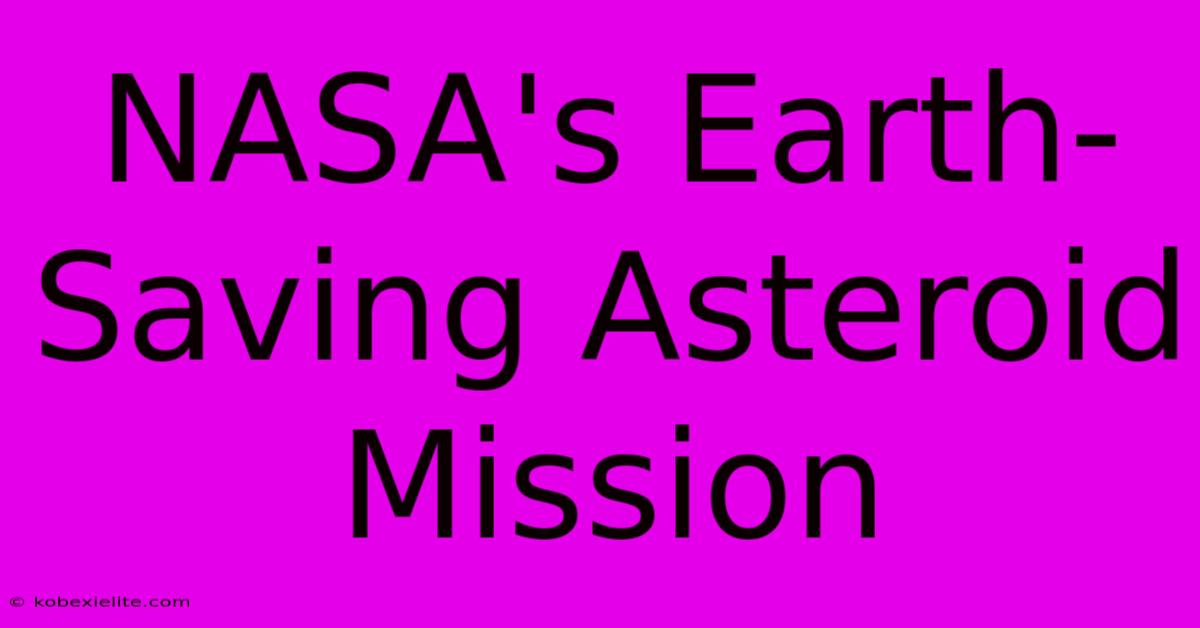NASA's Earth-Saving Asteroid Mission

Discover more detailed and exciting information on our website. Click the link below to start your adventure: Visit Best Website mr.cleine.com. Don't miss out!
Table of Contents
NASA's DART Mission: A Planetary Defense Success Story
The vast expanse of space holds both wonder and potential peril. Among the celestial bodies orbiting our sun are asteroids, some of which pose a threat to Earth. Recognizing this, NASA launched the Double Asteroid Redirection Test (DART) mission, a groundbreaking endeavor to test a method for deflecting potentially hazardous asteroids. This wasn't just a science experiment; it was a crucial step in developing planetary defense strategies.
Understanding the Threat: Asteroid Impacts
Asteroid impacts are not a futuristic fantasy; they're a real and recurring event in Earth's history. While most asteroids burn up harmlessly in the atmosphere, larger ones can cause significant damage, even global catastrophe. The Chicxulub impactor, believed to have wiped out the dinosaurs 66 million years ago, serves as a stark reminder of the potential devastation.
The Need for Planetary Defense
The potential for a devastating asteroid impact necessitates proactive measures. While the probability of a large impact in the near future is relatively low, the consequences are so severe that developing effective defense strategies is paramount. NASA's DART mission is a critical component of this global effort.
DART: A Kinetic Impactor Mission
DART employed a simple yet effective technique: kinetic impact. The spacecraft, equipped with sophisticated navigation systems and a camera, autonomously targeted Dimorphos, a small moon orbiting the larger asteroid Didymos. The goal wasn't to destroy the asteroid but to slightly alter its trajectory.
The Impact and its Results
On September 26, 2022, DART successfully collided with Dimorphos at a speed of approximately 14,000 mph. The impact altered Dimorphos' orbital period around Didymos, shortening it by 32 minutes – a far greater change than initially predicted. This significant shift demonstrated the viability of the kinetic impactor technique as a potential planetary defense method.
Beyond DART: Future Planetary Defense Strategies
The success of DART is a monumental achievement, but it's just one step in a larger, ongoing process. Future planetary defense strategies will likely involve:
- Improved asteroid detection and tracking: Identifying potentially hazardous asteroids early is crucial. Advanced telescopes and surveillance systems are essential for monitoring the skies.
- Further testing and refinement: More missions are needed to test and refine different deflection techniques. This includes exploring alternative methods like gravity tractors or ion beam shepherd spacecraft.
- International collaboration: Planetary defense is a global challenge requiring international cooperation. Sharing data, technology, and resources is crucial for effective protection.
The Importance of Continued Research
The DART mission's success doesn't signal the end of the threat; rather, it underscores the importance of continued research and development in planetary defense. By investing in advanced technologies and international collaboration, we can significantly reduce the risk of a devastating asteroid impact.
Conclusion: A Milestone in Planetary Defense
NASA's DART mission represents a significant milestone in planetary defense. The successful alteration of Dimorphos' orbit demonstrates the feasibility of kinetic impact as a viable deflection technique. This achievement, however, underlines the continued need for ongoing research, technological advancements, and global collaboration to ensure the safety and security of our planet. The future of planetary defense depends on our commitment to proactive measures and sustained vigilance in the face of potential cosmic threats.

Thank you for visiting our website wich cover about NASA's Earth-Saving Asteroid Mission. We hope the information provided has been useful to you. Feel free to contact us if you have any questions or need further assistance. See you next time and dont miss to bookmark.
Featured Posts
-
Merseyside Derby Brawl Four Reds
Feb 13, 2025
-
Rex Airlines Federal Buyout Looms
Feb 13, 2025
-
Byd Sealion 7 2025 Price And Details
Feb 13, 2025
-
Ind Vs Eng Final Odi Before World Cup
Feb 13, 2025
-
Ingrams 120 M Raptors Contract Official
Feb 13, 2025
